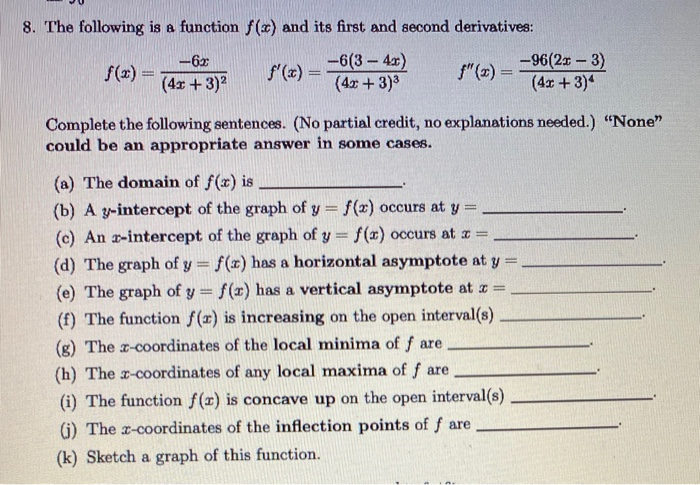8. The following is a function f(x) and its first and second derivatives: -6(3- 4x) (4x +3)3 "(2) = 96(2r- 3) (4x+3)4 -6x f(x) = f (x) = %3D (4x + 3)2 Complete the following sentences. (No partial credit, no explanations needed.) "None" could be am appropriate answer in some cases. (a) The domain of f(x) is (b) A y-intercept of the graph of y = f(x) occurs at y = (c) An x-intercept of the graph of y = f(x) occurs at z = %3D (d) The graph of y f(x) has a horizontal asymptote at y = (e) The graph of y = f(x) has a vertical asymptote at z = (f) The function f(r) is increasing on the open interval(s) (g) The r-coordinates of the local minima of f are (h) The x-coordinates of any local maxima of f are (i) The function f(x) is concave up on the open interval(s) (i) The x-coordinates of the inflection points of f are (k) Sketch a graph of this function.
Permutations and Combinations
If there are 5 dishes, they can be relished in any order at a time. In permutation, it should be in a particular order. In combination, the order does not matter. Take 3 letters a, b, and c. The possible ways of pairing any two letters are ab, bc, ac, ba, cb and ca. It is in a particular order. So, this can be called the permutation of a, b, and c. But if the order does not matter then ab is the same as ba. Similarly, bc is the same as cb and ac is the same as ca. Here the list has ab, bc, and ac alone. This can be called the combination of a, b, and c.
Counting Theory
The fundamental counting principle is a rule that is used to count the total number of possible outcomes in a given situation.
Solve early parts c and d onlys.

Trending now
This is a popular solution!
Step by step
Solved in 2 steps with 2 images


